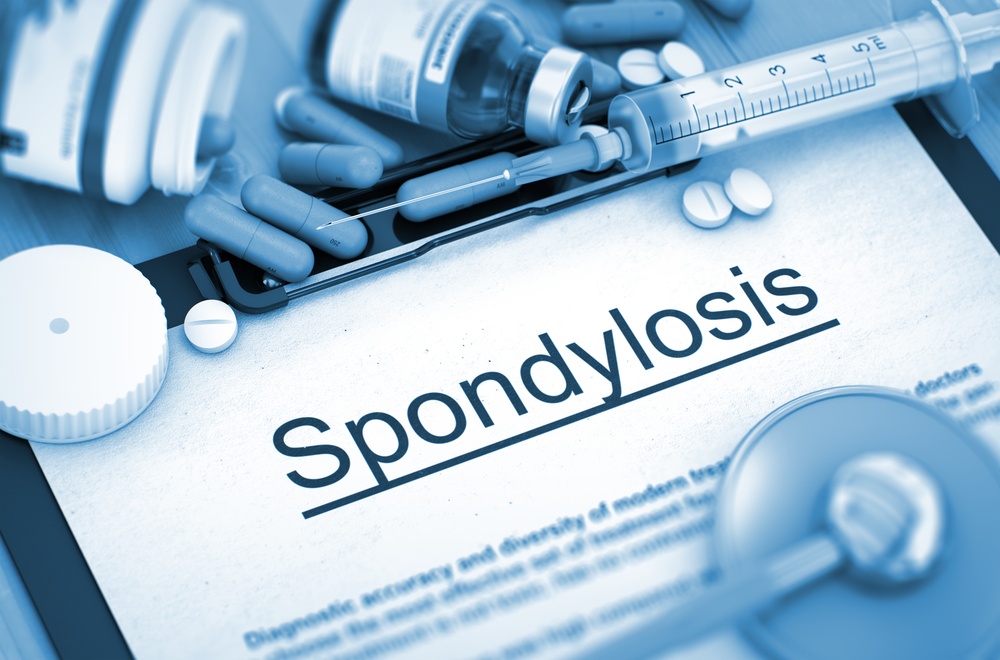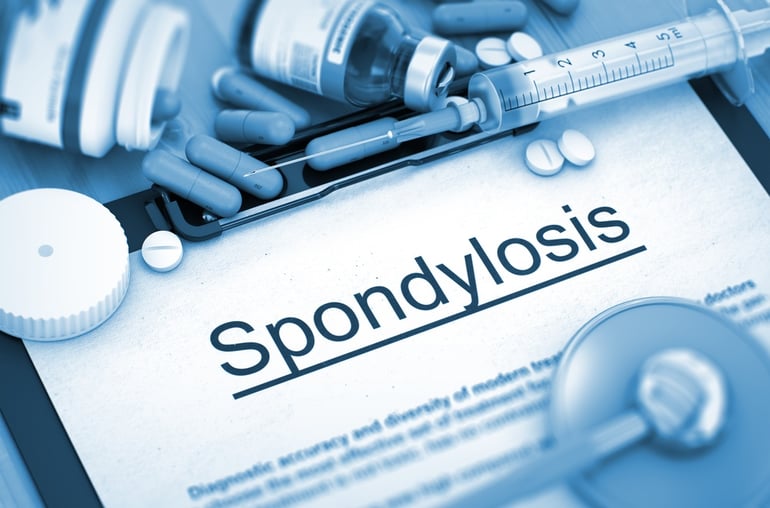WHAT IS SPONDYLOSIS? (SIGNS AND SYMPTOMS)
July 31st, 2017 | 4 min. read


Degenerative spondylosis is a somewhat broad medical term used to describe age-related degeneration, or breakdown, of the spine. If your orthopedic physician diagnoses you with spondylosis, he or she is telling you that your back or neck pain—and other related symptoms—are age-related, a result of the normal wear and tear of living.
If you have this form of spondylosis, some part of your spine, be it the vertebrae themselves, the discs between them, or the surrounding cartilage or ligaments, has broken down to the point where your joints have become affected—contributing to another condition such as osteoarthritis, spinal stenosis, or compression of your nerves (leading to issues like sciatica).
Spondylosis and Degenerative Disc Disease
Occasionally, people will ask the question, “Is spondylosis the same thing as degenerative disc disease, or DDD?” The answer is “basically, yes.” The terms are often used interchangeably. (A third term, more accurate than DDD, is “disc degeneration.”)
Spondylosis may be the initial diagnosis used to describe age-related back or neck pain, and maybe some numbness or tingling in your legs or feet. Upon further examination and testing, your orthopedist may find that the specific source of your spondylosis, as well as its effects; for example, you may have a worn lumbar disc that’s causing two vertebrae in your lower back to grind against each other, triggering the growth of bone spurs that put pressure on your surrounding nerves.
Some orthopedists prefer to use the word spondylosis over the term degenerative disc disease because the condition is not truly a disease, but a mechanical issue—the gradual breakdown of the discs between the vertebrae due to the ordinary wear and tear of aging. (Or in some cases, the wear and tear brought on by traumatic injury.)
Also, this type of wear-and-tear is not a degenerative condition in the classic sense, in that it isn’t caused by changes in the body at the cellular level—nor does it get predictively, progressively worse over time. (However, osteoarthritis—a frequent and perhaps inevitable result of disc degeneration—is degenerative, which is why the terms are often used interchangeably.)
Who Gets Degenerative Spondylosis? (Risk Factors)
Spondylosis can happen to anyone—in fact, an estimated 80% of men and women over 40 are likely to show some sign of spinal degeneration on their X-rays. People with symptoms tend to first notice them between the ages of 20 and 50.
If you notice symptoms at a younger age, there may be a genetic component to your particular case. Having a history of injuries can also increase your likelihood of developing spondylosis. For example, some studies indicate that whiplash sustained in a car accident may make you more likely, years after the accident, to get surgery to repair or remove a damaged disc.
But for the most part, spondylosis is the result of aging. Most people will experience it as they get older, but not everyone will require (or desire) a medical intervention.
Spondylosis Causes (Why it Occurs)
As we age, our discs lose water and proteins; they dry out, becoming stiff and brittle. Repetitive stress to the neck or back can create micro-tears and other traumas in the outer shells.
Activities that used to be easy—bending over to pick up a delivery box, swinging a golf club, or even twisting around to say hello to someone behind you at the store—may lead to a disc injury or slipped disc. Unfortunately, these injuries don’t repair themselves as easily when we’re older.
The discs’ isolation within the spinal column means they don’t have the same access to a nutrient-rich blood supply as other types of collagen/cartilage in the body (for example, the outer parts of the knee, the elbow, or the Achilles tendon). They can’t self-repair quickly. Pair this with the loss of water and proteins due to the natural aging process, and this means we sustain damage to our necks and backs that may take a good deal of time to fix—or the help of a doctor.
Types of Spondylosis (Where it Occurs)
Disc degeneration usually occurs in the cervical vertebrae (the neck) or in the lumbar vertebrae (the lower back). After testing, your orthopedist may diagnose you with cervical spondylosis or lumbar spondylosis.
The types of symptoms that you experience will depend on the extent of the damage to the affected intervertebral disc and how that damage creates a domino effect on the surrounding nerves, bone, and tissue.
Common responses to spondylosis include:
- Bone spurs. When discs degrade and the space between vertebrae decreases, the resulting bone-on-bone friction can cause extra bone to grow on the tops and bottoms of vertebrae. Bone spurs may project into the spinal canal, contributing to spinal stenosis and nerve compression.
- Disc herniation. If a damaged disc develops a split in its outer wall, the gel-like substance on the inside can push through its container, creating a bulge. This bulging disc may press into the surrounding spinal canal and push against a nerve. This is often referred to as a “slipped disc” or “herniated disc.” Disc herniations can result in nerve pain, numbness, and tingling.
- Loss of the cushioning between vertebrae can lead to bone spurs, as described above, and osteoarthritis of the facet joints of the spine. With arthritis, the main symptoms will be pain and stiffness.
- Pinched or inflamed nerves. Herniated (bulging) or slipped discs can put pressure on nerves running through the spinal canal. This is often referred to as a pinched nerve or nerve compression. When this nerve compression affects the lower back and legs, a patient may be diagnosed with:
- When the disc (or something else, like a tumor or bone spur) presses against a nerve root anywhere along the spine.
- Sciatica. When the disc presses on nerve roots near the base of the spine, creating symptoms in the legs and feet.
- Myelopathy: When the herniated disc presses on the spinal cord itself, creating a spinal cord injury.
- Stenosis. Discs may press up on the holes (foramina) in the vertebrae, creating a narrowing of that space (called a stenosis), which can put pressure on the nerves running through the vertebrae. Spinal stenosis, a narrowing of the spinal canal due to any number of factors (including bone spurs or slipped discs), can also lead to pinched nerves.
- Pinched or inflamed ligaments. Herniated discs can press on ligaments much the way they press on nerves. This can cause pain and inflammation.
Spondylosis Symptoms
Different people experience disc degeneration in different ways, with varying manifestations. Symptoms can differ depending on the location and the specific type of disc degeneration, and what that breakdown of the disc is doing to surrounding nerves and tissue. You may barely notice a problem, whereas someone else may experience numbness in their extremities or chronic pain in their lower back or neck.
If you have spondylosis, you may notice one or more of the following, depending on the specifics of your case:
- Headaches
- Loss of bladder control
- Muscle spasms
- Pain and soreness in the neck, shoulders, or lower back; pain may worsen with standing (if it originates in the lower back) or moving the head (if it originates in the neck)
- Stiffness
- Tenderness
- Tingling or pins-and-needles sensation that radiates down the arms or legs
- Weakness in the arms or legs
Getting a Diagnosis of Spondylosis
If you think you may have spondylosis and your symptoms are interfering with your quality of life, your next step is to make an appointment to see a doctor. Spondylosis needs to be confirmed with lab testing like X-rays, CT scans, or MRIs.
Once you’ve been diagnosed, you and your orthopedist can work together to discuss your options for treatment. To discuss further please contact Coastal Orthopedics today at (361) 994-1166.
Article written by: Rob Williams, MD
Dr. Williams has been practicing orthopedic surgery in Corpus Christi since 1998. After graduating from Texas Tech hereceived his medical degree from the University of Texas at San Antonio. At the prestigious Campbell Clinic located at the University of Tennessee, Dr. Williams completed not only an Orthopedic Surgery Residency, but an additional year of Fellowship Training in Spine Surgery. Dr. Williams is dedicated to creating an excellent patient experience in the office or in the surgery suite.
Topics:

